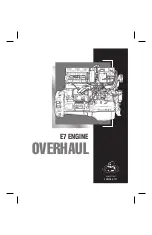
EB-10X Installation & Service Manual |
Introduction
5 Kollmorgen | kdn.kollmorgen.com | October 2020
1
INTRODUCTION
This installation and service manual is a general document and is applicable to a typical
amplifier needed to properly control the EB-10X motor series. However, since these motor
amplifiers are interfaced with motors of varying sizes having different operating
characteristics such as internal resistance, inductance, rotor inertia, etc., these amplifiers
vary with the motors with which they are compatible. Consult the manufacturer of the
amplifier for the installation and service manual pertaining to the specific amplifier used. After
the typical amplifier and a motor are connected, the motor must perform per the motor’s
nameplate data.
The customer data (CD) and performance curve (PC) are specified documents and are
applicable only to individual motors. They contain such information as maximum operating
speed, peak current limits, and values, which make the amplifier motor combination
compatible. Do not operate the motor outside the parameters shown on the respective
performance curves.
Typical amplifiers are of the 3-phase sine wave, pulse-width modulated type. They are full
regenerative four-quadrant bi-directional velocity loop amplifiers designed to be used with
Kollmorgen’s high-performance permanent magnet brushless motors.
An unregulated 300 VDC bus, derived from full-wave rectification of a 3-phase 230 AC line by
the power supply unit, is used to power the motor amplifier.
Kollmorgen brushless motors feature the latest in permanent magnet technology, utilizing
high energy Samarium-Cobalt and Neodymium-Iron-Boron alloys. These brushless motors
consist of permanent magnet rotors and 3-phase Y-stator windings. Brushless motors have
no commutators or associated brushes. These motors run as synchronous motors, meaning
the rotor speed is the same as the speed (frequency) of the rotating stator magnetic field. A
brushless resolver is utilized as the feedback device and is mounted internally as part of the
overall motor construction.
Benefits of the typical amplifier and brushless motor construction are:
Lower rotor inertia allows higher acceleration rates.
The motor is thermally more efficient since all heat is generated in the stator windings,
which are in the outside shell.
Higher speed operation and high peak horsepower are achieved. There is no
commutation limit.
Smaller physical motor size for a given HP rating.
Higher reliability and less motor maintenance. There is no commutator or brushes.
Smooth output torque.






































